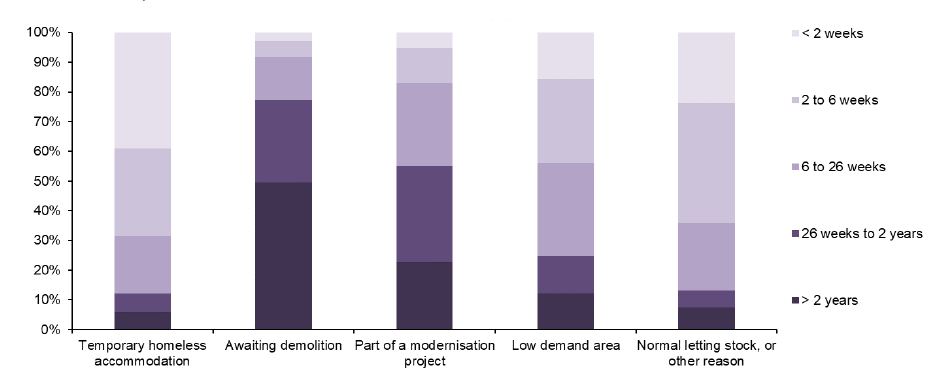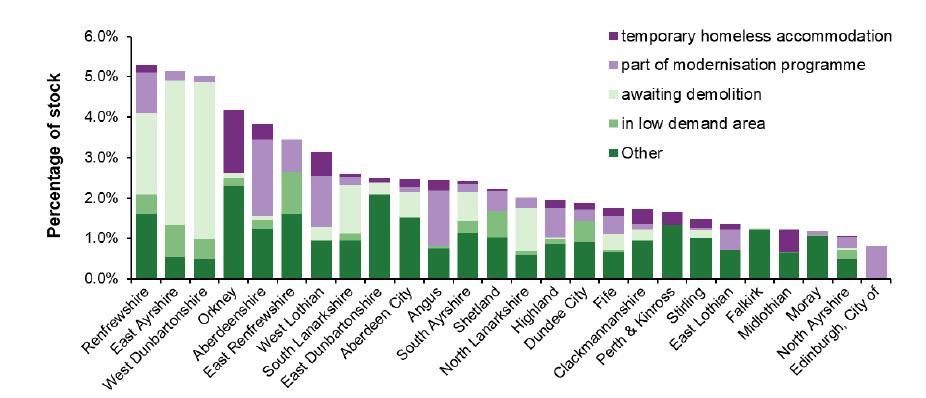Housing statistics 2019: key trends summary
Annual statistics up to 31 March 2018 on total new housing supply in Scotland across all sectors, along with information on various elements of local authority housing such as stock, lettings, house sales, evictions, housing lists, and housing for older people and people with disabilities.
Local Authority Vacant Stock
At 31st March 2019 local authorities reported 7,409 units of vacant stock, an increase of 4% (269 units) on the 7,140 units in the previous year.
There were increases in the number of vacant units awaiting demolition (an increase of 141 units, or 7%, from 2,067 to 2,208) and vacant normal letting stock (an increase of 171, or 7%, from 2,611 to 2,782), with vacant units in low demand areas and vacant units used as temporary accommodation for the homeless showing similar figures to the previous year. There was a decrease in the number of vacant units part of a modernisation programme (a decrease of 55, or 4%, from 1,485 to 1,430).
Local authority dwellings can be vacant for a variety of reasons, such as being part of a planned disposal or modernisation/repair programme, or being in low demand areas. Of the 7,463 units, 30% were awaiting demolition or sale, 7% were in a low demand area, 19% were part of a modernisation programme, and a further 6% were used as temporary accommodation for the homeless. Of the vacant stock, 38% was normal letting stock or other vacant stock, which represents 1% of all local authority normal letting stock.
Chart 11 below illustrates that the length of time that properties have been vacant is closely related to the reason for the vacancy. Normal letting stock, or temporary homeless accommodation tends to be empty for less time than other types of vacant stock. For example, at March 2019 just under one quarter (24%) of vacant normal letting stock had been vacant for less than two weeks, and only 7% had been vacant for over two years. This compares to half (50%) of vacant stock awaiting demolition which was vacant for over two years, and just 3% vacant for less than two weeks.
Chart 11: In 2018-19% 50% of vacant stock awaiting demolition has been vacant for more than 2 years, and 39% of vacant stock used as temporary accomodation for the homeless has been vacant for less than 2 weeks

Vacant stock in each local authority area (except those which have transferred their social housing stock) is shown in Chart 12. This shows vacant stock, by reason for vacancy, as a proportion of all local authority housing stock.
Chart 12: The types of vacant local authority stock as a proportion of local authority stock varied between each local authority in 2018-19

Link to tables on public authority vacant stock: http://www.scotland.gov.uk/Topics/Statistics/Browse/Housing-Regeneration/HSfS/StockManagement
Link to Scottish Government Social Tenants Statistics, which includes information on vacant stock across both the local authority and housing association sectors:
https://www.gov.scot/publications/social-tenants-scotland-2017/
National Records for Scotland (NRS) produce statistics on occupied and vacant dwellings for all sectors each year at local authority and data zone level: http://www.nrscotland.gov.uk/statistics-and-data/statistics/statistics-by-theme/households/household-estimates
Contact
Email: lyndsey.middleton@gov.scot
There is a problem
Thanks for your feedback